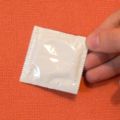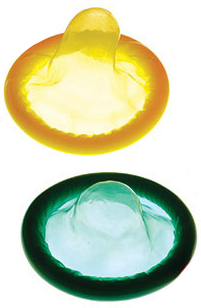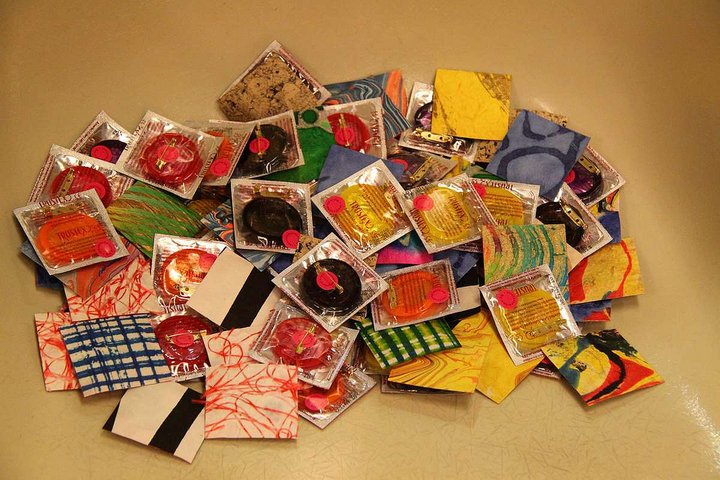A condom is a thin rubber covering that a man wears on his penis during the sexual intercourse in order to prevent a woman from becoming pregnant or to prevent the spread of sexually transmitted diseases.
Things you probably didn’t know about condoms
- Condoms have non-sexual use as well, such as creating waterproof microphones.
- There also exist female condoms.
- Condoms have been used for at least 400 years.
- Condoms are considered unacceptable in almost all situations by certain religions; it was so notably in Catholic Church, until the Pope himself non-officially allowed the use of condoms in some cases.
- In Asia, before the 15th century, some use of glans condoms (devices covering only the head of the penis) is recorded.
- In Japan, condoms were made of tortoise shell or animal horn.
- In the late 15th century, Dutch traders introduced condoms made from “fine leather” to Japan. Unlike the horn condoms used previously, these leather condoms covered the entire penis.
- Casanova in the 18th century was one of the first persons reported using “assurance caps” to prevent impregnating his mistresses.
- Germany outlawed all civilian use of condoms in 1941.
Since the 19th century condoms have been one of the most popular methods of contraception in the world. Whether condoms were used in ancient civilizations or not is widely debated today. In ancient Egypt, Greece and Rome, pregnancy prevention was generally seen as a woman’s responsibility. Condoms seem to have only been known and used for contraception by members of the upper classes in Japan. They were using glans condoms in China that may have been made of oiled silk paper or lamb guts (intestines).
From at least the 18th century, condom use was opposed in some legal, religious and medical circles for essentially the same reasons given today; condoms reduce the likelihood of pregnancy, which some thought immoral or undesirable for the nation, condoms do not provide full protection against sexually transmitted infections (STIs), while belief in their protective powers was thought to encourage people to have more casual sex with different partners. And they are not used consistently due to inconvenience, expense, sensation loss. Despite this opposition, the condom market grew rapidly. Condoms were available in a variety of qualities and sizes and were sold at pubs, barbershops, pharmacies, open-air markets, and theatres throughout Europe and Russia, later spreading to America.
American, European and Asian militaries provided condoms to their troops throughout the Second World War, even Germany which outlawed all civilian use of condoms at that time.
Already in 1970, in India alone they were consuming hundreds of millions of condoms annually.
After learning in the early 1980s that HIV is a sexually transmitted infection, condom use was encouraged to prevent its transmission. Despite the opposition manifested by some political, religious, and other figures, national condom promotion campaigns occurred in the US and Europe, increasing condom use significantly. Worldwide condom use is expected to continue to grow: one study predicted that developing nations would need 18.6 billion condoms by 2015. Condoms have become an integral part of modern societies.
As World Health Organisation informs, the consistent and right use of condom reduces the risk of STI transmission till 95 percent relative to the risk when unprotected.

Never use the same condom twice. Do not use two condoms simultaneously; instead of “double protection” the condoms will rub each other doubling the risk of getting an STI as the quality of condoms will suffer. Here are some instructions on condom use in the right way:
- Open the condom packet at one corner being careful not to tear the condom with your fingernails, your teeth (if opening with your mouth) or through being too rough.
- Make sure the packet and condom appear to be in good condition, and check that the expiry date has not passed.
 Place the rolled condom over the tip of the hard penis, whilst pinching the tip of the condom enough to leave a half inch space for semen to collect. Only put on a condom once there is a partial or full erection. If the penis is not circumcised, pull back the foreskin before rolling on the condom.
Place the rolled condom over the tip of the hard penis, whilst pinching the tip of the condom enough to leave a half inch space for semen to collect. Only put on a condom once there is a partial or full erection. If the penis is not circumcised, pull back the foreskin before rolling on the condom.- Roll the condom all the way down to the base of the penis, and smooth out any air bubbles (which may harm the condom).
- After the intercourse, when taking the member out, hold it with your fingers so that the condom isn’t left inside.
 Remove the condom from your penis while it is still erect or half-erect. Tie the condom so that the semen would not spill.
Remove the condom from your penis while it is still erect or half-erect. Tie the condom so that the semen would not spill.- Wrap the condom with a toilet paper, napkin or similar thing and throw it into the garbage bin. One shall not throw the condom into the toilet: it will not be washed away by water for a long time, it may also plug the toilet.
When you buy a condom, don’t get embarrassed. If anything, be proud. It shows that you are responsible and confident. It is not only for your own safety, but for the safety of your partner, too.
It can be more fun to go shopping for condoms with your partner or friend. Nowadays, it is also easy to buy condoms discreetly on the internet. You may buy condoms from pharmacies. Some NGOs provide condoms as well. You may visit PINK Armenia, too, in case if you or your friends need condoms.
Yet, people are sometimes overwhelmed with stereotypes and prejudice about condoms and their use. Apart from saying it’s just unhelpful and reduces the natural pleasure, some even think that it’s a shame to use a condom. There are some men that think only immoral women shall use condoms and they stand firmly against the idea of condom use with their girlfriends or wives. People are sometimes ashamed to buy a condom. Some men even pay extra money to sex workers so that they would have the intercourse without any condom. Believe it or not, some people consider condom itself to be something unpleasant; if a condom accidentally interacts with something, they will refuse to touch that thing.
It is up to us to make our own mind; it reduces the pleasure? The fact is that modern condoms are not that rough and thick to reduce one’s sensibility. If it’s OK to skip the condom, then it shall be totally “OK” to catch a disease or to pass one onto another person. It is immoral to use a condom, but it will be moral to infect someone or to get an infection? Our wives and women shall not use condoms? Well, tell that to those who are contaminated with STIs, HIV included. The simple and effective step that could protect was dismissed and underestimated. Many women and men have paid a serious price for that, both in towns and villages of Armenia. Is it acceptable to abhor and abstain from using something that protects you and your beloved one (or your partner)?
Above all, care for your health and for your beloved one rather caring for your stereotypes and prejudice.
It is much cheaper and easier
To pay before
for a small thing made of rubber,
Than to pay after…
For a visit to the doctor.
We also consider it notable to mention that by presenting this article, we have no intention to promote any type of sexual lifestyle; it is every person’s own decision. Our sole intention is to promote a safer sexual behaviour.
Nvard Margaryan
Sevak Kirakosya
n





